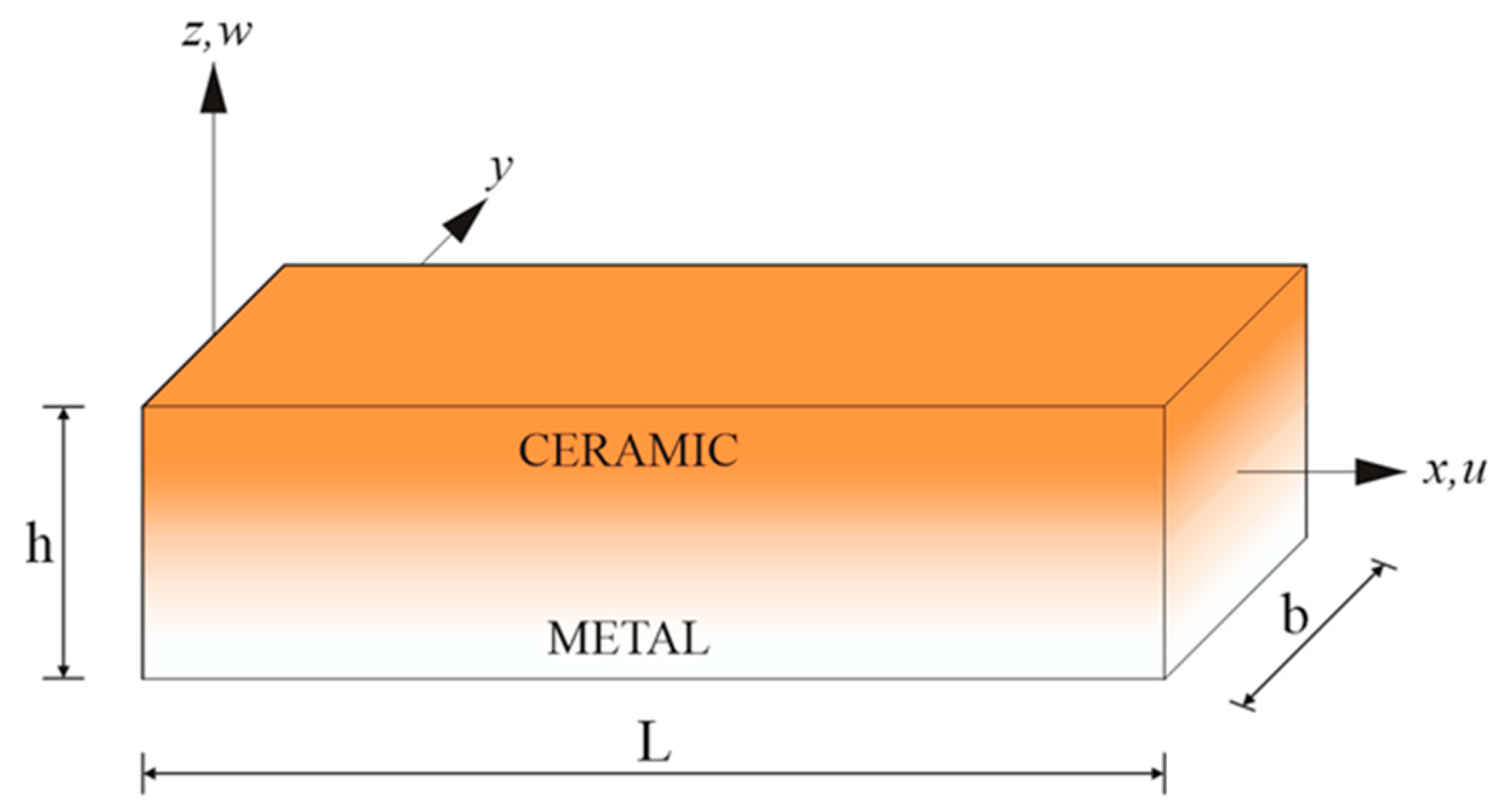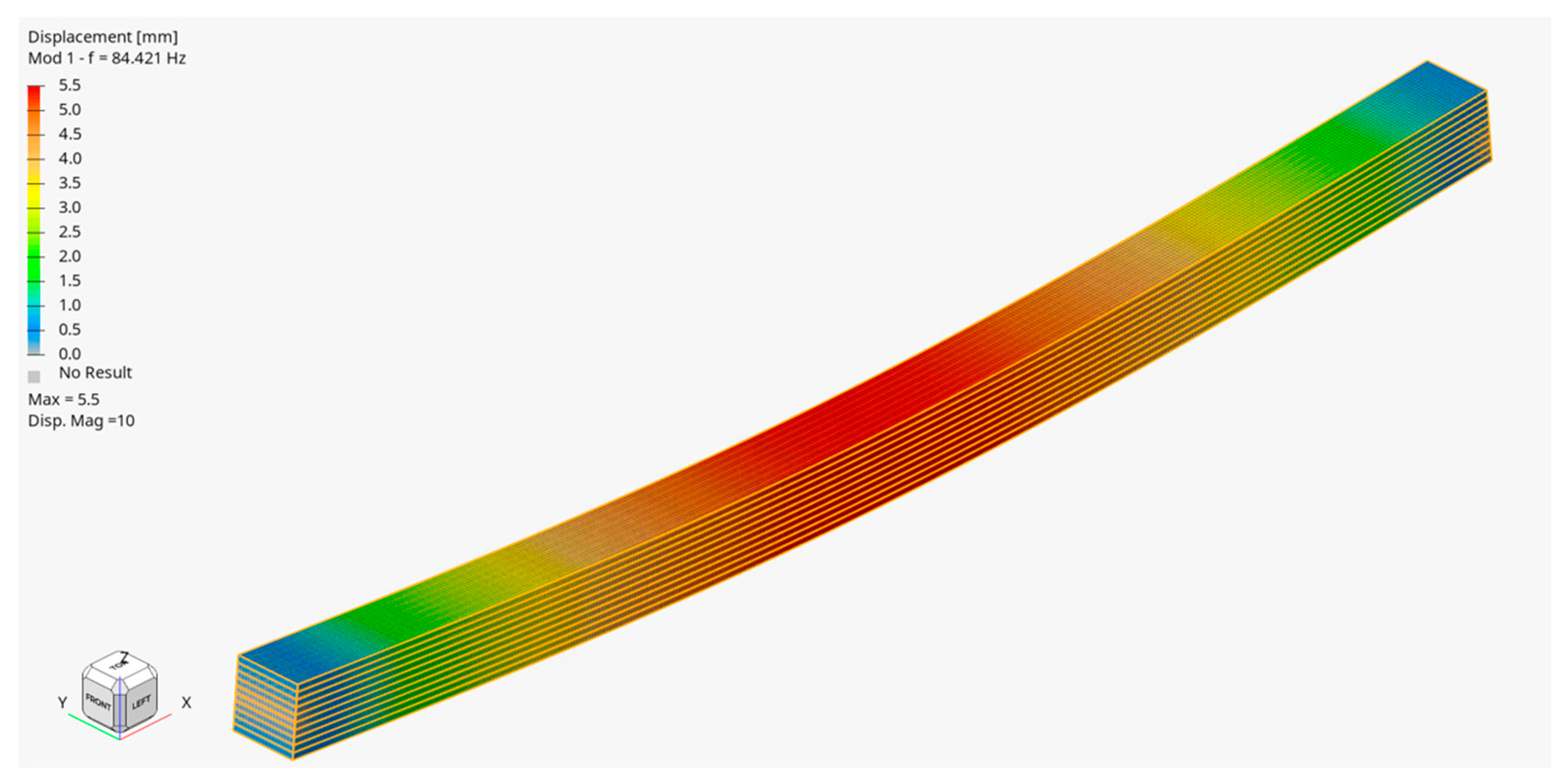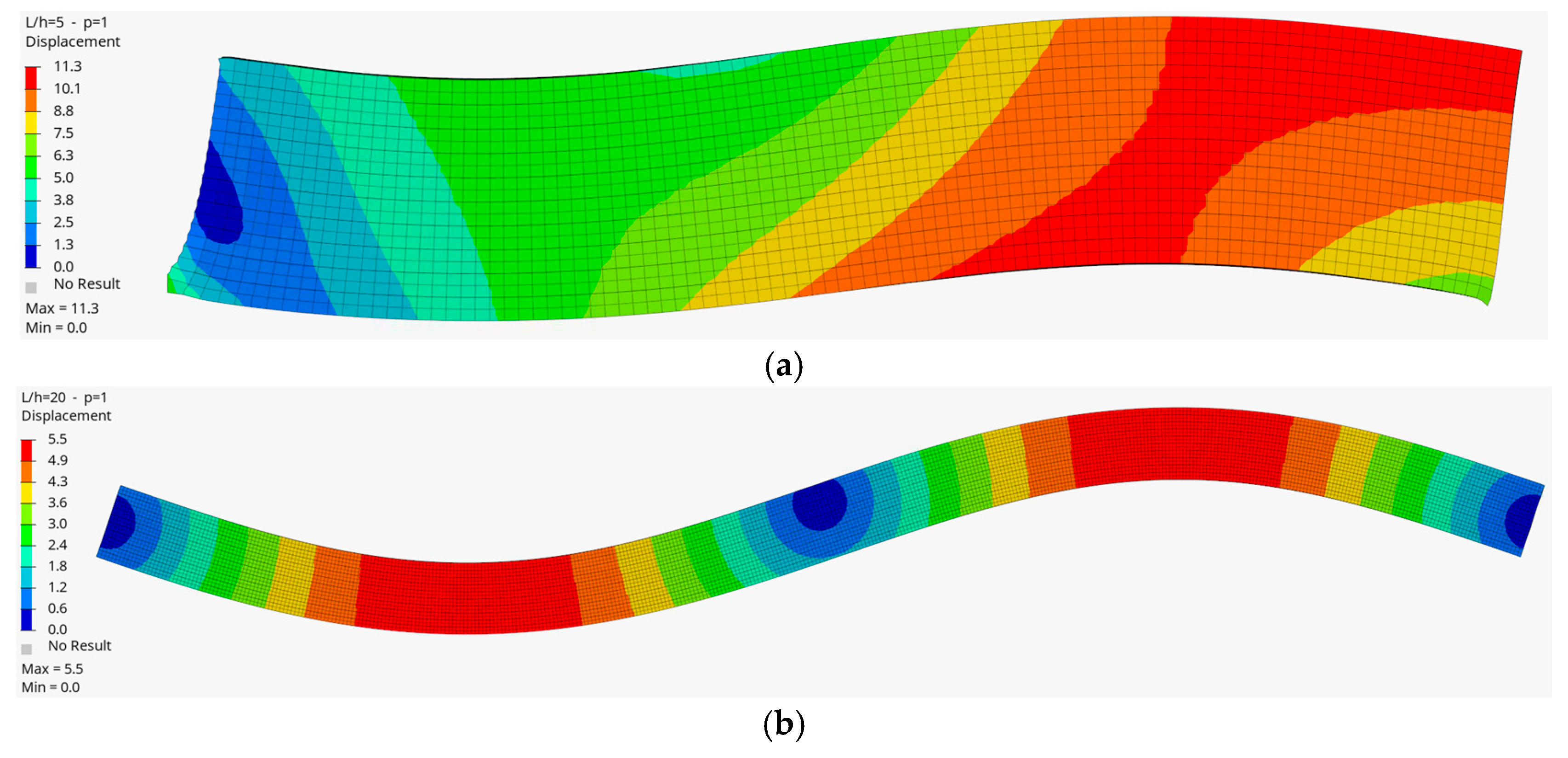Analytical and Numerical Investigation of Vibration Characteristics in Shear-Deformable FGM Beams
Abstract
1. Introduction
2. Theory and Formulation
2.1. Material Properties
2.2. Constitutive Equations
2.3. Equations of Motion
3. Solution Procedure
3.1. Analytical Part of Solution
3.2. Numerical Part
4. Results and Discussion
| L/h | p | Present (TBT) | ABAQUS (HEX20) | ABAQUS (Timoshenko 1D) | Chen et al. [33] | CBT [31] |
|---|---|---|---|---|---|---|
| 0 | 5.1524 | 5.1563 | 5.1569 | 5.1525 | 5.3953 | |
| 0.5 | 4.4078 | 4.2450 | 4.2354 | 4.4079 | 4.5931 | |
| 1 | 3.9902 | 3.9370 | 3.9623 | 3.9904 | 4.1484 | |
| 5 | 2 | 3.6343 | 3.6021 | 3.4407 | 3.6346 | 3.7793 |
| 5 | 3.4312 | 3.4200 | 2.7061 | 3.4315 | 3.5949 | |
| 10 | 3.3134 | 3.2315 | 2.5960 | 3.3136 | 3.4921 | |
| 50 | 2.9288 | 3.1269 | 2.6182 | - | - | |
| 0 | 5.4603 | 5.4612 | 5.4607 | 5.4603 | 5.4777 | |
| 0.5 | 4.6509 | 4.4791 | 5.0114 | 4.6509 | 4.6641 | |
| 1 | 4.2050 | 4.1685 | 4.5509 | 4.2051 | 4.2163 | |
| 20 | 2 | 3.8367 | 3.8463 | 3.8015 | 3.8368 | 3.8472 |
| 5 | 3.6508 | 3.6858 | 2.8814 | 3.6509 | 3.6628 | |
| 10 | 3.5415 | 3.4493 | 2.7494 | 3.5416 | 3.5547 | |
| 50 | 3.1207 | 3.3338 | 2.7724 | - | - |
| L/h | p | Present (TBT) | ABAQUS (HEX20) | ABAQUS (Timoshenko 1D) | Chen et al. [33] | CBT [27] |
|---|---|---|---|---|---|---|
| 0 | 17.8711 | 15.0112 | 15.1155 | 17.8711 | 20.6187 | |
| 0.5 | 15.4263 | 12.9269 | 12.3368 | 15.4277 | 17.5415 | |
| 1 | 14.0030 | 11.8785 | 11.9982 | 14.0064 | 15.7982 | |
| 5 | 2 | 12.7120 | 10.6079 | 10.5592 | 12.7179 | 14.3260 |
| 5 | 11.8157 | 9.4636 | 8.2881 | 11.8226 | 13.5876 | |
| 10 | 11.3073 | 9.0001 | 7.6107 | 11.3119 | 13.2376 | |
| 50 | 10.0500 | 8.7717 | 7.6743 | - | - | |
| 0 | 21.5732 | 21.5831 | 21.5782 | 21.5732 | 21.8438 | |
| 0.5 | 18.3931 | 17.7203 | 19.2787 | 18.3931 | 18.5987 | |
| 1 | 16.6344 | 16.4784 | 17.6408 | 16.6344 | 16.8100 | |
| 20 | 2 | 15.1715 | 15.1744 | 14.8756 | 15.1715 | 15.3334 |
| 5 | 14.4109 | 14.5201 | 11.3722 | 14.4110 | 14.5959 | |
| 10 | 13.9652 | 13.6022 | 10.8641 | 13.9653 | 14.1676 | |
| 50 | 12.3146 | 13.1533 | 10.9555 | - | - |
| L/h | p | Present (TBT) | ABAQUS (HEX20) | ABAQUS (Timoshenko 1D) | Chen et al. [33] | CBT [27] |
|---|---|---|---|---|---|---|
| 0 | 34.1449 | 34.2776 | 34.2807 | 34.1449 | 43.3483 | |
| 0.5 | 29.7166 | 28.9559 | 20.8563 | 29.7231 | 36.8308 | |
| 1 | 27.0525 | 26.8252 | 20.7280 | 27.0683 | 33.0278 | |
| 5 | 2 | 24.4970 | 23.9218 | 19.8466 | 24.5242 | 29.7458 |
| 5 | 22.4642 | 20.9403 | 17.6138 | 22.4933 | 28.0850 | |
| 10 | 21.3219 | 20.9403 | 17.2456 | 21.3399 | 27.4752 | |
| 50 | 19.0238 | 19.3222 | 17.4048 | - | - | |
| 0 | 47.5921 | 47.6399 | 47.6167 | 47.5921 | 48.8999 | |
| 0.5 | 40.6377 | 39.1212 | 40.9196 | 40.6378 | 41.6328 | |
| 1 | 36.7673 | 36.2973 | 37.8398 | 36.7677 | 37.6173 | |
| 20 | 2 | 33.5135 | 33.2699 | 32.3465 | 33.5142 | 34.2954 |
| 5 | 31.7473 | 31.7229 | 25.0470 | 31.7482 | 32.6357 | |
| 10 | 30.7174 | 29.9764 | 23.9720 | 30.7180 | 31.6883 | |
| 50 | 27.1162 | 28.9962 | 24.1755 | - | - |
5. Conclusions
Author Contributions
Funding
Institutional Review Board Statement
Informed Consent Statement
Data Availability Statement
Conflicts of Interest
References
- Qian, L.F.; Batra, R.C.; Chen, L.M. Static and dynamic deformations of thick functionally graded elastic plates by using higher-order shear and normal deformable plate theory and meshless local Petrov–Galerkin method. Compos. Part B Eng. 2004, 35, 685–697. [Google Scholar] [CrossRef]
- Reddy, J. Thermomechanical Behavior of Functionally Graded Materials, 1st ed.; Department of Mechanical Engineering, Texas A&M University: College Station, TX, USA, 1998; pp. 3–20. [Google Scholar]
- Rahmani, A.; Babaei, A.; Faroughi, S. Vibration Characteristics of Functionally Graded Micro-Beam Carrying an Attached Mass. Mech. Pf Adv. Compos. Struct. 2020, 7, 49–58. [Google Scholar]
- Sedighi, H.M.; Keivani, M.; Abadyan, M. Modified continuum model for stability analysis of asymmetric FGM double-sided NEMS: Corrections due to finite conductivity, surface energy and nonlocal effect. Compos. Part B Eng. 2015, 83, 117–133. [Google Scholar] [CrossRef]
- Alshorbagy, A.E.; Eltaher, M.A.; Mahmoud, F.F. Free vibration characteristics of a functionally graded beam by finite element method. Appl. Math. Model. 2011, 35, 412–425. [Google Scholar] [CrossRef]
- Avcar, M. Free vibration of imperfect sigmoid and power law functionally graded beams. Steel Compos. Struct. 2019, 30, 603–615. [Google Scholar]
- Kahya, V.; Turan, M. Finite element model for vibration and buckling of functionally graded beams based on the first-order shear deformation theory. Compos. Part B Eng. 2017, 109, 108–115. [Google Scholar] [CrossRef]
- Çelik, M.; Artan, R. An investigation of static bending of a bi-directional strain-gradient Euler–Bernoulli nano-beams with the method of initial values. Microsyst. Technol. 2020, 26, 2921–2929. [Google Scholar] [CrossRef]
- Kareem, M.G.; Sadiq, S.E.; Al-Raheem, S.K.; Alansari, L.S. Analysis the free vibration of functionally graded material plate by using new displacement function. Results Eng. 2025, 25, 103756. [Google Scholar] [CrossRef]
- Su, X.S.; Hu, T.; Zhang, W.; Kang, H.; Cong, Y.; Yuan, Q. Transfer matrix method for free and forced vibrations of multi-level functionally graded material stepped beams with different boundary conditions. Appl. Math. Mech. 2024, 45, 983–1000. [Google Scholar] [CrossRef]
- El Hantati, I.; Ouyassafte, O.; El Khouddar, Y.; Belhaou, M.; Adri, A.; Benamar, R. Analysis of the transverse vibration of a multistepped FGM beam resting on a Winkler foundation in a thermal environment and carrying concentrated masses. Results Eng. 2024, 23, 102822. [Google Scholar] [CrossRef]
- Wang, Y.; Liu, B.; Zhu, J.; Zhou, W.; Jiang, L.; Pan, C.; Xu, J. Thermal vibration of stiffened FGM plates with cutouts using Nitsche-based isogeometric approach. Thin-Walled Struct. 2025, 210, 113026. [Google Scholar] [CrossRef]
- Hilali, Y.; Rassam, M.; Mesmoudi, S.; Sitli, Y.; Elmhaia, O.; Rammane, M.; Askour, O.; Bourihane, O. A high-order approach for thermal buckling and post-buckling analysis of functionally graded sandwich beams. Acta Mech. 2025, 236, 3543–3563. [Google Scholar] [CrossRef]
- Pradhan, K.K.; Chakraverty, S. Free vibration of Euler and Timoshenko functionally graded beams by Rayleigh–Ritz method. Compos. Part B Eng. 2013, 51, 175–184. [Google Scholar] [CrossRef]
- Yıldırım, B. Investigation of thermal shock fracture in an edge-cracked functionally graded layer using finite element method. J. Fac. Eng. Archit. Gazi Univ. 2004, 19, 235–245. [Google Scholar]
- Kahya, V.; Turan, M. Vibration and stability analysis of functionally graded sandwich beams by a multi-layer finite element. Compos. Part B Eng. 2018, 146, 198–212. [Google Scholar] [CrossRef]
- Nguyen, T.K.; Nguyen, B.D. A new higher-order shear deformation theory for static, buckling and free vibration analysis of functionally graded sandwich beams. J. Sandw. Struct. Mater. 2015, 17, 613–631. [Google Scholar] [CrossRef]
- Echouai, B.; Adri, A.; El Khouddar, Y.; Outassafte, O.; El Hantati, I.; Echouai, E.K.; Hassa, M.; Benamar, R. Analysis of transverse vibrations of functionally graded beams with magnetostrictive Terfenol-D layers resting on an elastic foundation. Sci. Afr. 2025, 28, e02651. [Google Scholar] [CrossRef]
- Benadouda, M.; Bourouis, M.E.A.; Dahmane, M.; Bennai, R.; Atmane, H.A.; Safer, O. Dynamic response of wave propagation in functionally graded beams with defects: Effects of porosity and cracks. Acta Mech. 2025, 236, 2279–2296. [Google Scholar] [CrossRef]
- Jayachandiran, G.; Ramamoorthy, M. Free and forced vibration analysis of functionally graded composite beam with graphene filler reinforcement—Experimental and simulation study. Polym. Compos. 2025, 46, S70–S85. [Google Scholar] [CrossRef]
- Priyadarshini, A.; Sutar, M.K.; Pattnaik, S. Refined Higher-Order Shear Deformation Analysis of Axial Functionally Graded Beams With Nano-Graphene Reinforcement. J. Vib. Eng. Technol. 2025, 13, 236. [Google Scholar] [CrossRef]
- Hedia, H.S.; Almas, M.A.; Attar, H.M.; Hedia, M.H.; Gadelmawla, E.S.; Soliman, M.A. Numerical and analytical stress analysis for a FGM beam. Mater. Test. 2025, 67, 1046–1055. [Google Scholar] [CrossRef]
- Abood, N.K.; Al-Ansari, L.S. Impact of porosity distribution on vibration of porous functionally graded beams. Math. Model. Eng. Probl. 2025, 12, 687–708. [Google Scholar] [CrossRef]
- Özmen, U.; Özhan, B.B. Mechanics of functionally graded beams: Analytical, computational, and experimental analyses. Int. J. Mech. Mater. Des. 2025, 21, 577–590. [Google Scholar] [CrossRef]
- Khan, A.A.; Alam, M.N.; ur Rahman, N.; Wajid, M. Finite element modelling for static and free vibration response of functionally graded beam. Lat. Am. J. Solids Struct. 2016, 13, 690–714. [Google Scholar] [CrossRef]
- Chakraborty, A.; Gopalakrishnan, S.; Reddy, J.N. A new beam finite element for the analysis of functionally graded materials. Int. J. Mech. Sci. 2003, 45, 519–539. [Google Scholar] [CrossRef]
- Thai, H.T.; Vo, T.P. Bending and free vibration of functionally graded beams using various higher-order shear deformation beam theories. Int. J. Mech. Sci. 2012, 62, 57–66. [Google Scholar] [CrossRef]
- Larbi, O.L.; Kaci, A.; Houari, M.S.A.; Tounsi, A. An Efficient Shear Deformation Beam Theory Based on Neutral Surface Position for Bending and Free Vibration of Functionally Graded Beams. Mech. Based Des. Struct. Mach. 2013, 41, 421–433. [Google Scholar] [CrossRef]
- Aydogdu, M.; Taskin, V. Free vibration analysis of functionally graded beams with simply supported edges. Mater. Des. 2007, 28, 1651–1656. [Google Scholar] [CrossRef]
- Dassault Systemes, “ABAQUS FEA”. 2024. Available online: https://www.3ds.com/products/simulia/abaqus (accessed on 20 August 2025).
- Çelik, M.; Gündoğdu, E.; Özdilek, E.E.; Demirkan, E.; Artan, R. Artificial Neural Net-work (ANN) Validation Research: Free Vibration Analysis of Functionally Graded Beam via Higher-Order Shear Deformation Theory and Artificial Neural Network Method. Appl. Sci. 2024, 14, 217. [Google Scholar] [CrossRef]
- Zohra, Z.; Lemya, H.; Abderahman, Y.; Mustapha, M.; Abdelouahed, T.; Djamel, O. Free vibration analysis of functionally graded beams using a higher-order shear deformation theory. Math. Model. Eng. Probl. 2017, 4, 7–12. [Google Scholar] [CrossRef]
- Chen, W.R.; Chang, H. Vibration Analysis of Functionally Graded Timoshenko Beams. Int. J. Struct. Stab. Dyn. 2018, 18, 185007. [Google Scholar] [CrossRef]










Disclaimer/Publisher’s Note: The statements, opinions and data contained in all publications are solely those of the individual author(s) and contributor(s) and not of MDPI and/or the editor(s). MDPI and/or the editor(s) disclaim responsibility for any injury to people or property resulting from any ideas, methods, instructions or products referred to in the content. |
© 2025 by the authors. Licensee MDPI, Basel, Switzerland. This article is an open access article distributed under the terms and conditions of the Creative Commons Attribution (CC BY) license (https://creativecommons.org/licenses/by/4.0/).
Share and Cite
Çelik, M.; Demirkan, E.; Yıldırım, A.F. Analytical and Numerical Investigation of Vibration Characteristics in Shear-Deformable FGM Beams. J. Compos. Sci. 2025, 9, 567. https://doi.org/10.3390/jcs9100567
Çelik M, Demirkan E, Yıldırım AF. Analytical and Numerical Investigation of Vibration Characteristics in Shear-Deformable FGM Beams. Journal of Composites Science. 2025; 9(10):567. https://doi.org/10.3390/jcs9100567
Chicago/Turabian StyleÇelik, Murat, Erol Demirkan, and Ahmet Feyzi Yıldırım. 2025. "Analytical and Numerical Investigation of Vibration Characteristics in Shear-Deformable FGM Beams" Journal of Composites Science 9, no. 10: 567. https://doi.org/10.3390/jcs9100567
APA StyleÇelik, M., Demirkan, E., & Yıldırım, A. F. (2025). Analytical and Numerical Investigation of Vibration Characteristics in Shear-Deformable FGM Beams. Journal of Composites Science, 9(10), 567. https://doi.org/10.3390/jcs9100567






